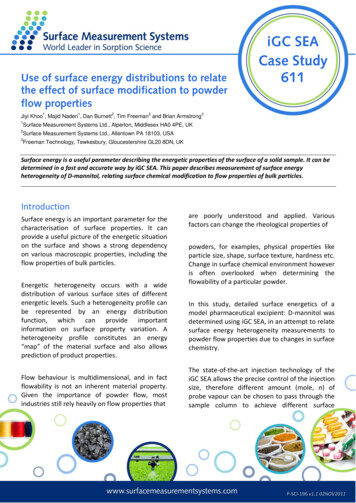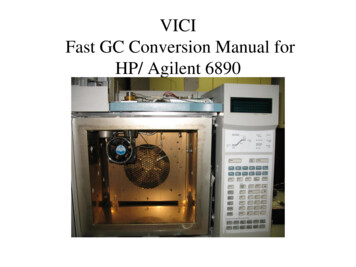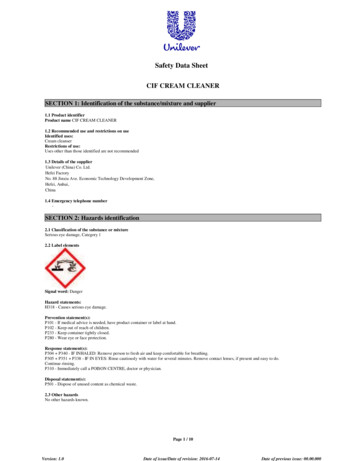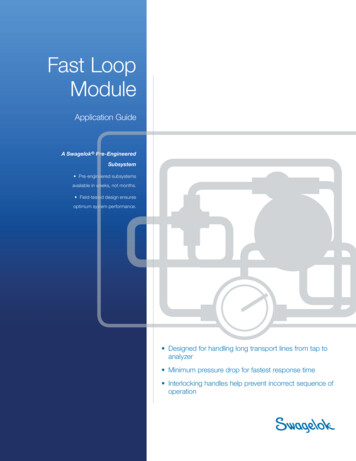
Transcription
1123Jiyi Khoo , Majid Naderi , Dan Burnett , Tim Freeman and Brian Armstrong1Surface Measurement Systems Ltd., Alperton, Middlesex HA0 4PE, UK2Surface Measurement Systems Ltd., Allentown PA 18103, USA3Freeman Technology, Tewkesbury, Gloucestershire GL20 8DN, UK3Surface energy is a useful parameter describing the energetic properties of the surface of a solid sample. It can bedetermined in a fast and accurate way by iGC SEA. This paper describes measurement of surface energyheterogeneity of D-mannitol, relating surface chemical modification to flow properties of bulk particles.IntroductionSurface energy is an important parameter for thecharacterisation of surface properties. It canprovide a useful picture of the energetic situationon the surface and shows a strong dependencyon various macroscopic properties, including theflow properties of bulk particles.Energetic heterogeneity occurs with a widedistribution of various surface sites of differentenergetic levels. Such a heterogeneity profile canbe represented by an energy distributionfunction, which can provide importantinformation on surface property variation. Aheterogeneity profile constitutes an energy“map” of the material surface and also allowsprediction of product properties.Flow behaviour is multidimensional, and in factflowability is not an inherent material property.Given the importance of powder flow, mostindustries still rely heavily on flow properties thatare poorly understood and applied. Variousfactors can change the rheological properties ofpowders, for examples, physical properties likeparticle size, shape, surface texture, hardness etc.Change in surface chemical environment howeveris often overlooked when determining theflowability of a particular powder.In this study, detailed surface energetics of amodel pharmaceutical excipient: D-mannitol wasdetermined using iGC SEA, in an attempt to relatesurface energy heterogeneity measurements topowder flow properties due to changes in surfacechemistry.The state-of-the-art injection technology of theiGC SEA allows the precise control of the injectionsize, therefore different amount (mole, n) ofprobe vapour can be chosen to pass through thesample column to achieve different surfaceP-SCI-196 v1.1 02NOV2011
coverages, n/nm. If a series of probe vapours isinjected at the same surface coverage, thesurface energy and free energy can bedetermined. Consequently, the injections ofprobe vapours at different surface coverages willresult in a distribution of surface energy as afunction of surface coverage, which is referred asa surface energy profile. The determination ofsurface energy heterogeneity by iGC SEA can,therefore, be described as a mapping technique.MethodMaterial – D-mannitolD‐mannitol (C6H14O6) was used as received(M4125 98%; Sigma Aldrich). D-mannitol is acrystalline pharmaceutical excipient, commonlyused in formulations for oral and chewabletablets, powder granules and moisture sensitiveAPIs [1]. Crystal habit is prismatic rod in shape, asshown in Fig. 1.OHOHSiSi SiMe2Cl2OMeMeSiOOSi 2 HClSiOFig. 2 Chemical reaction scheme for methylation of hydroxylgroupsThe methylation reaction (Fig. 2) occurred at thesurface of AR D-mannitol where dichlorodimethylsilane condensates the surface hydroxylgroups, with a concomitant evolution of hydrogenchloride. The liquid was decanted off afterreaction and the samples were dried in a vacuumoven at 80 C for 2 hours. This treatment ensuredthat a large portion of the surface hydroxylgroups were methylated and that all the solventwas evaporated. Subsequently both silanised andAR D-mannitol were sieved to 75-180μm particlesize fraction.Powder Flow MeasurementFig. 1 SEM image of AR D-mannitol particlesFlow tests were conducted using FT4 PowderRheometer (Freeman Technology, Tewkesbury,UK). Both samples were first sieved at 500μm toremove any soft agglomerates. Each sample wasthen held in a glass jar in which it was tumbledprior to testing to put it into a homogeneousstate with respect to segregation.Surface Modification - MethylationA 5% solution of dichlorodimethylsilane in 1,1,2trichlorethylene was used to promote surfacemethylation [2]. The solution was mixed with ARD-mannitol particles at 80 C for 3 hours underconstant reflux. During the course of the reaction,the mixture was agitated continuously to ensuregood dispersion.Fig. 2 FT4 Powder Rheometer (left) and dynamic flow test(right) Freeman Technology
Surface Energy HeterogeneityAll analyses were carried out using iGC SurfaceEnergy Analyzer (SMS, Alperton, UK) and the datawere analysed using both standard and advancedSEA Analysis Software. For all experiments, about2g of samples were packed into individualsilanised glass column (300mm long by 4mminner diameter) using the SMS Column PackingAccessory.This findings coincides with previous report ofcontact angle measurement and IGC finiteconcentrations on a native mannitol macroscopiccrystal, which has shown a high level of surfaceheterogeneity [5].55.0Silanised D-Mannitol50.0Dispersive S.E. [mJ/m2]All flow tests, including determination ofdynamic, bulk and shear properties were carriedout with a 23.5mm blade and a 25mm diametervessel. All measurements were repeated twice todemonstrate the repeatability of the FT4methodologies.surface energy changes as a function of surfacecoverage. There is a notable difference betweenmaximum and minimum SD values, ranging from37.51 to 52.63mJ/m2.AR 0.200.24Surface Coverage [n/nm]Fig. 3 Dispersive surface energy profiles (as a function ofsurface coverage).5.04.5Silanised D-Mannitol4.0Specific S.E. [mJ/m2]Samples were run at a series of surface coverageswith alkanes and polar probe molecules todetermine the dispersive surface energydistribution as well as the specific (acid-base)surface energy distribution. For the analysis,method of Dorris and Gray was employed fordispersive component [3]. Specific contributionwas determined by first measuring the freeenergy of desorption based on the polarisationapproach [4]. Each column was pre-conditionedfor 2 hours at 30 C and 0%RH with helium carriergas to remove any physisorbed water. Allexperiments were carried out at 30 C with10sccm total flow rate of helium, using methanefor dead volume corrections.AR 0.160.200.24Surface Coverage [n/nm]ResultsSurface Energy HeterogeneityDispersive, SD and specific (acid-base), SABsurface energy profiles obtained directly from theiGC SEA for both samples are shown in Fig. 3 andFig. 4, respectively.It can be clearly observed that AR D-mannitol isenergetically heterogeneous, meaning theFig. 4 Specific (acid-base) surface energy profiles.It is known that there is abundance of -OH groupswhich can be found on surfaces of AR D-mannitol.These hydroxyl groups were substituted with –Si(CH3)2 groups after methylation reaction.Hence, silanised surfaces became energeticallymore homogeneous, with relatively small mean SAB value of 1.60mJ/m2 – implying an isotropichydrophobic surface property (Fig. 5).
Fig. 6 Flowability energy as a function of aeration.0.090.08Wettability γAB / γT [-]0.070.060.050.040.03Silanised D-Mannitol0.02AR ace energy is directly related to thethermodynamic work of adhesion2 between twomaterials.Whenirreversiblechemicalinteractions are neglected and only physicalinteractions are present, the total work ofcohesion can be determined according togeometric mean method, as follows:Surface Coverage [n/nm]Fig. 5 Wettability, S / S profiles (as a function of surfacecoverage).ABTWCohtotal 2[( sD * sD)½ ( s * s-)½ ( s- * s )½] eqn. (1)Powder Flow CharacteristicsFlowability energy of AR D-mannitol wasobserved here reducing from 333.0 to 50.0mJ,before fully aerates and stabilises at 32.4mJ.Silanised D-mannitol however has a much lowerflowability energy and aerated energy, implying aless cohesive (more free-flowing) powderproperty.Total Flow Energy [mJ]400350Silanised D-Mannitol300AR D-MannitolSimilar trend can be observed in Fig. 7, of whichAR D-mannitol, due to its more active surfacesites and heterogeneous surface property, hasvariable and higher cohesive strength.120Silanised D-Mannitol110Work of Cohesion [mJ/m2]Results indicate clear rheological differencesbetween AR D-mannitol and silanised D-mannitol.Key flow characteristics of the samples aresummarised in Table 1. AR D-mannitol exhibitedunstable flow behaviour, in particular in theaeration test1, showing dramatic variability at lowair velocities, as presented in Fig. 6.AR .1250.150.2Surface Coverage [n/nm]Fig. 7 Thermodynamic work of cohesion as a function ofsurface coverage.Variability of AR D-mannitol is also evident in theconsolidation test. Consolidation Index (CI) refersto the ratio of energy needed to displace theconsolidated powder (after 50 taps) to the basicflowability energy. This further confirms thatsilanised D-mannitol is the more free-flowing ofthe two.2502001501005000246810121620Air Velocity [mm/s]24Silanised D-mannitol generates a slightly lowerwall friction angle (24.9 ), indicating that it islikely to flow more easily over typical metal1Ability of a powder to be influenced by air is a very goodindicator of the cohesive strength of powder, relating to thecapacity of air required to separate individual particles.2Thermodynamic work of adhesion is the work required toreversibly separate an interface between two bulk phases.
surfaces, such as those found in storage vessels orin processing equipment.Table 1: Key flow characteristics of ty Energy [mJ]333 4.6%87.7 1.7%Aerated Energy [mJ]32.4 5.7%19.1 2.4%Stability Index [-]1.05 1.1%1.06 0.1%Consolidation Index [-]2.14 14.5%1.46 3.6%Wall Friction Angle [ ]26.2 0.4%24.9 0.6%Flow MeasurementIt can be certain that both samples were stableduring the powder flow tests. There is neithersignificant particle attrition nor segregation, asindicated by the Stability Indices (SI values closeto unity for both samples).ConclusionIn summary, methylation process has clearlyimproved the flow properties of D-mannitol in alow-stress environment. Change in surfacechemistry; from a heterogeneous surfaceproperty to a homogeneous and low wettabilitysurface property has reduced the variability in allpowder flow properties, hence a more repeatableprocessing performance can be achieved.Powder behaviours of D-mannitol samples are inexcellent agreement with the detailed surfaceenergy distributions determined by iGC SEA. It isevident that energetic heterogeneity andhomogeneity of bulk powders, reflecting thesurface chemical environment, can be easilydistinguished using this technique.References[1][2][3][4][5]Yoshinari, T. et al. (2002) Moisture induced polymorphic transitionof mannitol and its morphological transformation. Int. J. Pharm.,247, p69-77.Al-Chalabi, S.A.M., Jones, A.R. and Luckham, P.F. (1990) A simplemethod for improving the dispersability of micro-sized solid spheres.J. Aerosol Sci., 21(6), p821-826.Dorris, G.M. and Gray, D.G. (1980) Adsorption of normal-alkanes atzero surface coverage on cellulose paper and wood fibers. J. Colloid& Interface Sci., 77(2), p353-362.Dong, S., Brendlé, M. and Donnet, J.B. (1989) Study of solid surfacepolarity by inverse gas chromatography at infinite dilution.Chromatographia, 28(9-10), p469-472.Ho, R. et al. (2010) Determination of surface heterogeneity of Dmannitol by sessile drop contact angle and finite concentrationinverse gas chromatography. Int. J. Pharm, 387(1-2), p79-86
Stability IndexAppendices:Table A: Surface energy values for Silanised 6.1035.6235.050.04410.04490.04480.04480.0445ABγ /γTStability Index is the factor by which the flow energyrequirement changes during repeat testing. Particleattrition, segregation, (de)agglomeration and (de)aerationcould result in instability.Consolidation IndexConsolidation Index refers to the factor by which the flowenergy is increased as a result of consolidation of thepowder before testing (by direct pressure, tapping orstorage, to specific conditions).CI energy of consolidated sample / BFEWall Friction Angle [ ]Table B: Surface energy values for AR 0.5643.4350.340.06650.08580.06700.07130.0796ABγ /γTDefinitionsSimilar to Shear Cell test however instead of the powderbeing forced to shear against itself, a disc of a knownsurface roughness (Ra) is forced to shear against thesurface of the powder bed whilst subjected to varyingnormal stresses.Wall friction angle is the shear angle required to initiatesteady-state flow for a powder sample relative to a givenmaterial of Ra (μm), for an applied normal consolidatingstress (kPa).**Further explanation of FT4 methodologies can be foundat www.freemantech.co.uk(Basic) Flowability Energy [mJ]BFE is the energy needed to displace a conditioned andstabilised powder at a given flow pattern and flow rate. BEFis calculated from the work done in moving the bladethrough the powder in a downward anti-clockwise motion.In this study, BFE was based on a sample volume of 160ml,using -5 helix blade and 100 mm/s of blade tip speed.Aerated Energy [mJ]The flow energy measured when air is being passedthrough the powder at a velocity (mm/s). The capacity of agas to separate the individual particles of a powder can beevidenced by the changes in flow energy measured underthe influence of increased air content. When aerated, lessenergy is normally required to move the powder.United States Office:Head Office:Surface Measurement Systems, Ltd, NASurface Measurement Systems, Ltdth2125 28 Street SW, Suite I5 Wharfside, Rosemont RoadAllentown PA, 18103, USALondon HA0 4PE, UKTel: 1 610 798 8299Tel: 44 (0)20 8795 9400Fax: 1 610 798 0334Fax: 44 (0)20 8795 9401Email: science@surfacemeasurementsystems.com
heterogeneity of D-mannitol, relating surface chemical modification to flow properties of bulk particles. Introduction Surface energy is an important parameter for the characterisation of surface properties. It can provide a useful picture of the energetic situation on the surface and shows a strong dependency











